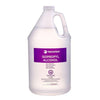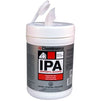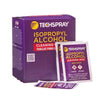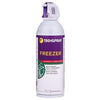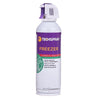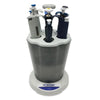- No products in the cart.
Ethanol Denatured vs. Ethanol Non-Denatured: Their Differences and The Top Uses
Feb
15
2021
What is Ethanol?
Ethanol, commonly referred to as grain alcohol, is an alcohol compound with an ethyl group attached. It is a common organic compound with numerous applications ranging from the development of alcoholic beverages, to a renewable biofuel. It can be found in a variety of commercial products and is an essential laboratory solvent.
Characteristically, it is a colorless, free flowing liquid with a burning taste and a vinous odor. Use caution when working with ethanol as it is highly flammable.
Ethanol's Chemical Properties:
- Ethanol Chemical formula: C2H6O,
- CAS #: 64-17-5
- Molar mass: 46.069 g·mol−1
- Boiling point: 78.23 ± 0.09[3] °C (172.81 ± 0.16 °F; 351.38 ± 0.09 K)
- Melting point: −114.14 ± 0.03[3] °C (−173.45 ± 0.05 °F; 159.01 ± 0.03 K)
- Solubility in water: Miscible
- Viscosity: 1.2 mPa·s (at 20 °C), 1.074 mPa·s (at 25 °C)
- Density: 0.78945 g/cm3 (at 20 °C)
-
GHS pictograms 

GHS Signal word Danger
What is Ethanol Used For?
Ethanol is used in such a variety of items and processes; it has a huge presence in nearly everyone’s daily life. Common products containing ethanol include:

Beauty Products: The cosmetic aisle is full of ethanol. It is what helps hairspray adhere to hair, it is the cleaning agent for your skin in face washes, and it is the preservative in lotions that helps keep them from separating.
Hand Sanitizer: Ethanol effectively sterilizes surfaces by killing harmful bacteria so it appears in numerous sanitizers at higher concentrations.
Food: Certain foods even have ethanol added directly into them like liquor candies, boozy cakes and meat to aid in tenderization. It is even a component in vanilla extract.
Fuel: The vast majority of gasoline in the United States contains ethanol. It was pushed as a gasoline additive due to its renewable status.
Alcoholic Beverages: Beer, wine and liquor are all developed from ethanol.
Bathroom Products: Even within your bathroom you can find ethanol. It is in your mouthwash to perform the necessary chemical breakdowns to break up the plaque on your teeth. Cough and cold medicine also are developed from ethanol.
Household cleaners: Ethanol’s ability to break down bacteria and act as a great solvent makes it’s a perfect medium to use to make household cleaners. Glass cleaner, tile cleaner, and floor cleaner all contain ethanol.
Laboratory Solvent: Ethanol mixes easily with water and organic content, making it a common solvent in laboratories. It even forms solution with some hydrocarbons and volatile compounds. This diversity makes it essential for numerous types of laboratories and methodologies.
How is Ethanol Made?
Ethanol is primarily developed from three different processes:
- Fermentation
Fermentation is the most prolific method in which ethanol is developed and it is a process that occurs naturally. Organic plant material is broken down by yeast cells. The yeast will then ferment the starch and sugar from the plant material into alcohol. The most common materials used are corn stalks, sugar cane, and beets. These plants are the most efficient producers of ethanol because of their high sugar and starch content. The US primarily uses corn because of the abundance that is produced nationwide.
- Hydration of Ethylene
This process is performed by combining ethylene, a large volume of steam and an acidic catalyst. The resulting product from that reaction is ethanol. This is an efficient chemical reaction because as long as steam and ethylene are fed into the system, ethanol will continue to be produced. The downside is that ethylene is a petrochemical and thus is not renewable.
- Cellulosic Ethanol
Ethanol is derived from this method by a complicated breakdown of cellulose from plant material. This method of extraction is primarily being looked at in the biofuel industry because it uses grasses and trees which are much cheaper and easier to grow than the grains used in fermentation.
What’s the Difference Between Ethanol Denatured and Non-Denatured?
Non-Denatured ethanol is in its original, extracted form and it has not been modified with any additives. You would see undenatured alcohol in a clinical laboratory in where blood alcohol content is tested, or in a laboratory method that is testing for ethanol presence in soil or water. The alcohol that is for human consumption is also undenatured including your beers, wines and liquors.
Denatured ethanol has additives (denaturants) placed in it to discourage consumption. These denaturants are added to compounds that are not safe or intended for human ingestion. They do not alter any of the properties of the ethanol but usually add an unpleasant taste to the product. Most common uses, including laboratory uses, will use ethanol in its denatured form.
Where Can You Buy Ethanol?
Check with a laboratory chemical provider, and they will likely be able to supply you with ethanol. If you unsure if your process requires denatured or undenatured ethanol, contact Lab Pro for assistance selecting the right chemical for your needs. Whether your needed volume is a pint, a drum, or in a gallon format, they can service your ethanol needs and inquiries.
Conclusion
Ethanol has a variety of purposes that are extremely commonplace and beneficial. It is a great disinfectant, preservative, and solvent. It comes in various concentrations, often referred to as a proof. Consumable ethanol like beer or liquor has a much lower proof than those not intended for consumption. The higher proof of ethanol used can cause serious health effects and should not be ingested, which is why the ethanol in those products is denatured. Regardless of its form, its powerful use as a fuel and renewable status promises a shared future between us and ethanol.
For over 40 years, Lab Pro Inc. has been committed to delivering the highest quality chemicals like Ethanol, ESD protection, laboratory and cleanroom PPE supplies to medical device and electronic manufacturing laboratories worldwide. To learn more, visit the biggest Lab Supply showroom in California, or contact us online or at 888-452-2776.
References
Ethanol. (n.d.). Retrieved February 10, 2021, from https://www.britannica.com/science/ethanol
Ethanol uses, benefits, and chemical safety facts. (2020, June 09). Retrieved February 10, 2021, from https://www.chemicalsafetyfacts.org/ethanol/
Ethanol. (n.d.). Retrieved February 10, 2021, from https://pubchem.ncbi.nlm.nih.gov/compound/ethanol#section=Therapeutic-Uses
U.S. energy Information administration - eia - independent statistics and analysis. (n.d.). Retrieved February 10, 2021, from https://www.eia.gov/energyexplained/biofuels/ethanol.php







